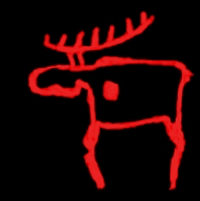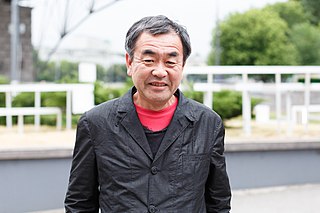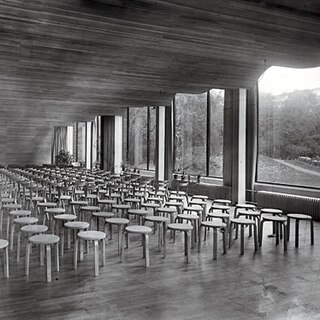Recipients of the Spirit of Nature Wood Architecture Award
| Year | Recipient | Country |
|---|---|---|
| 2000 | Renzo Piano | |
| 2002 | Kengo Kuma | |
| 2004 | Richard Leplastrier | |
| 2006 | Peter Zumthor | |
| 2008 | José Cruz Ovalle | |
| 2010 | Hermann Kaufmann | |
| 2012 | Bijoy Jain |
| Spirit of Nature Wood Architecture Award | |
|---|---|
| Awarded for | Exemplifying a progressive and creative use of wood in architecture |
| Sponsored by | Wood in Culture Association (Puu kulttuurissa ry) |
| Reward(s) | €40,000 |
| First awarded | 2000 |
The Spirit of Nature Wood Architecture Award was an international architecture award, awarded every two years, from 2000 until 2012, when it was discontinued. The award was founded by the Wood in Culture Association (Puu kulttuurissa ry), a Finnish association sponsored by the Finnish wood industry. The award is given to a person or group of persons whose work exemplifies a progressive and creative use of wood. The prize money was €40,000. The award was made at a ceremony held at the Sibelius Hall in the city of Lahti. The award was given a total of seven times. A few of the award winners afterwards received commissions to design a small structure in Lahti. [1]
| Year | Recipient | Country |
|---|---|---|
| 2000 | Renzo Piano | |
| 2002 | Kengo Kuma | |
| 2004 | Richard Leplastrier | |
| 2006 | Peter Zumthor | |
| 2008 | José Cruz Ovalle | |
| 2010 | Hermann Kaufmann | |
| 2012 | Bijoy Jain |

Christopher Wolfgang Alexander is a widely influential British-American architect and design theorist, and currently emeritus professor at the University of California, Berkeley. His theories about the nature of human-centered design have affected fields beyond architecture, including urban design, software, sociology and others. Alexander has designed and personally built over 100 buildings, both as an architect and a general contractor.

Lahti is a city and municipality in Finland. It is the capital of the region of Päijänne Tavastia (Päijät-Häme) and its growing region is one of the main economic hubs of Finland. Lahti is situated on a bay at the southern end of lake Vesijärvi about 100 kilometres (60 mi) north-east of the capital Helsinki. It is also situated at the intersection of Highway 4 and Highway 12, which are the most significant main roads of Lahti.

Ernő Rubik is a Hungarian inventor, architect and professor of architecture. He is best known for the invention of mechanical puzzles including Rubik's Cube (1974), Rubik's Magic, Rubik's Magic: Master Edition, and Rubik's Snake.
A haltija (haltia) is a spirit, gnome, or elf-like creature in Finnish mythology that guards, helps, or protects something or somebody. The word is possibly derived from the Gothic *haltijar, which referred to the original settler of a homestead—although this is not the only possible etymology. It can also be derived from the Finnish verb hallita, which means 'to rule', 'to command', 'to master'.

Finnish paganism was the indigenous pagan religion in Finland and Karelia prior to Christianisation. It was a polytheistic religion, worshipping a number of different deities. The principal god was the god of thunder and the sky, Ukko; other important gods included Jumi (Jumala), Ahti, and Tapio. Jumala was a sky god; today, the word "Jumala" refers to the Christian God. Ahti was a god of the sea, waters and fish. Tapio was the god of forests and hunting.

Finnish Neopaganism, or the Finnish native faith is the contemporary revival of Finnish paganism, the pre-Christian polytheistic ethnic religion of the Finns. A precursor movement was the Ukonusko of the early 20th century. The main problem in the revival of Finnish paganism is the nature of pre-Christian Finnish culture, which relied on oral tradition which may be subject to change over time. The primary sources concerning Finnish native culture are written by latter-era Christians.

Arno Rafael Minkkinen is a Finnish-American photographer who works in the United States.

Kengo Kuma is a Japanese architect and professor in the Department of Architecture at the University of Tokyo. Frequently compared to contemporaries Shigeru Ban and Kazuyo Sejima, Kuma is also noted for his prolific writings. He is the designer of the New National Stadium, Tokyo which has been built for 2020 Summer Olympics.

The architecture of Finland has a history spanning over 800 years, and while up until the modern era the architecture was strongly influenced by currents from Finland's two respective neighbouring ruling nations Sweden and Russia, from the early 19th century onwards influences came directly from further afield: first when itinerant foreign architects took up positions in the country and then when the Finnish architect profession became established.

Professor Richard Leplastrier AO is an Australian architect and AIA Gold Medal recipient, he is also a Professor of Practice (Architecture) at the University of Newcastle, Australia.

Rainer Mahlamäki is a Finnish architect, president of the Finnish Association of Architects (SAFA) from 2007 to 2011, Professor of Contemporary Architecture at the University of Oulu, and joint partner with Ilmari Lahdelma of the Helsinki-based architecture firm Lahdelma & Mahlamäki Architects, one of the most prolific such firms in Finland. A significant part of their work started as entries in architectural competitions, in which they have received 35 first prizes.

The Pilke House is a combined office building and science centre in Rovaniemi, Finland, built in 2011, which is notable for its low carbon footprint and the use of sustainable wood products in its design.

Pekka Salminen is a Finnish Professor of Architecture and founder and a senior partner of PES-Architects, formed in 1968, in Helsinki, Finland. He is also the founder of Unije Workshop International UWI, and the Centre for Architecture and Urban Planning, formed in Unije, Croatia, in 1987.

Otaniemi Chapel is a Lutheran chapel located in the Otaniemi campus of Aalto University in Espoo, Finland.

JKMM Architects is a Finnish architectural firm. Asmo Jaaksi, Teemu Kurkela, Samuli Miettinen and Juha Mäki-Jyllilä established JKMM Architects in 1998. They started their studies in the middle of eighties. From the beginning, architectural innovation has been the driving force of their work. Studio's design approach reflects Scandinavian values and aesthetics. Their goal is to make architecture with exceptional architectural and technical quality. Over the years JKMM has grown and it employs over 80 professionals. They operate actively in various areas and scales of architecture designing buildings, interiors, furniture, urban environments as well as renovations.
Helena Lehtinen is a Finnish contemporary jeweller and teacher.

Hermann Kaufmann is an Austrian architect.

Löyly is a public sauna, restaurant and bar in Hernesaari, Helsinki, Finland. Its address is Hernesaarenranta 4. Löyly opened in 2016.

Autobahnkirche Siegerland or Autobahnkirche an der A 45 is an ecumenical Christian road church at the Bundesautobahn 45 near Wilnsdorf, North Rhine-Westphalia, Germany. Opened in 2013, the building has received several architecture awards.
| This article about an architecture award is a stub. You can help Wikipedia by expanding it. |